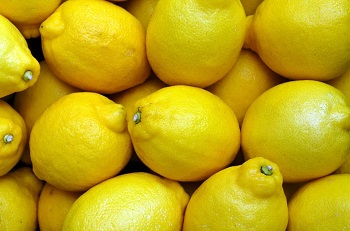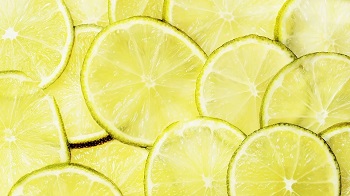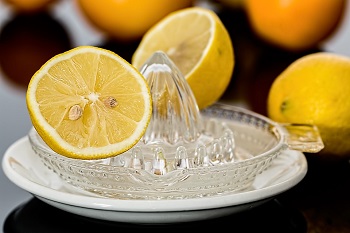You may have noticed that there are some recipes that will call for the zest of a lemon, or the juice of one lemon. But how much juice is in a lemon exactly? What is zest and how much zest can you find in a lemon? These are just a few of the questions that pop up all the time on the internet.
To find out the exact amount of zest or juice you will find in a lemon, we used a few medium-sized lemons, that weighed around 3.6 ounces each. You will usually find that 3 to 5 lemons will weigh one pound, depending on their size. As a general average, you will find around 2 tablespoons of lemon juice inside each lemon. You will also find around 1 tablespoon of zest inside each lemon.
This means that you will have to add 2 tablespoons of bottled juice every time the recipe will require the use of one lemon’s worth of juice. At the same time, you will have to add 1/2 worth of fresh lemon to get one tablespoon of lemon juice. You should use fresh lemons instead of bottled juice any time you have to possibility because the juice that comes from fresh lemons is a lot more complex and healthier than bottled juice.
Here’s a nice piece of general information: The lemon tree is considered an evergreen tree. Lemons won’t turn yellow when they ripe; instead, they will change color only due to temperature changes. The lemon tree was first found in China, North Burma, around India, and in other parts of Asia.
So to wrap up this general info chapter, each lemon should have around two tablespoons of juice inside of it. If you find it hard to juice the lemons, then we recommend that you use a hand juicer. One of the better brands is the Bellemain Squeezer because it makes it very easy to juice everything from oranges, limes to lemons. If you want to get the zest out but it is harder than you thought, then you should go for a zester or even a microplane. A microplane will work great with ginger, garlic, and nutmeg as well.
What Is a Lemon?
Lemons are fruits that belong to the citrus family, which grow in small-sized evergreen trees. You can find these trees all around the works, even though they were first found in parts of Asia.
They contain high amounts of vitamin C and pectin. Their seeds are not poisonous, but they do taste bitter.
Are there multiple types of lemons?
 Although lemons aren’t usually sold by variety, you should know that most lemons that you can find in stores are either Eureka or Lisbon lemons. There are also Meyer lemons, which are a combination of sweet orange and lemon, which are known for the lo0wer level of acid than other types of lemons. You will spot Meyer lemons due to their larger size and sweeter taste.
Although lemons aren’t usually sold by variety, you should know that most lemons that you can find in stores are either Eureka or Lisbon lemons. There are also Meyer lemons, which are a combination of sweet orange and lemon, which are known for the lo0wer level of acid than other types of lemons. You will spot Meyer lemons due to their larger size and sweeter taste.
In stores, you will also find preserved lemons, that have been kept with salt and are sold in jars. They will usually have a very strong flavor and are used mainly in Mediterranean recipes.
These fruits are usually round or oval and when ripe, they shouldn’t weigh more than 3 to 4 ounces each. You will notice they have a bright yellow color on the outside, and a yellow flesh inside that grows in sections that are split by membranes. Their insides are very similar to the inside of oranges, even though their taste will be different.
Are lemons vegetables or fruits?
Lemons are considered fruits. They are small and grow on very small trees.
They are used not only in savory recipes but also for cosmetic or cleaning purposes. You can use the rind, juice, and flesh for cooking, in all kinds of recipes. You will find that cosmetic and cleaning products use mostly oil made from lemons.
What does a lemon look like and how does it taste?
You will usually find lemons that are round or elliptical in shape, with a nipple-shaped part opposing the stem. Their peel is thick and will get yellow on the outside as it gets ripe. The flesh will be split into individual sections by membranes, just like you would find in limes or oranges.
Their seeds can be eaten, are in no way poisonous, but will taste horrible. Lemons will differ in acidity level based on their variety, but all of them are mouth-puckering.
What are lemons good for?
You will usually find lemons in recipes for cakes, bars, pudding, or in different dishes with fish, beef, pork, or vegetables. They are mostly used to lighten up a heavy dish or one that is full of fat.
What can you substitute lemons with?
You will usually be able to substitute a lemon with either a lime or an orange.
Most recipes will end up tasting almost the same if you replace lemon juice with a few drops of lemon extract, half as much white wine or vinegar, or the same amount of orange or lime juice. These substitutes will only slightly affect the flavor. You can substitute fresh lemon juice with bottled lemon juice without an issue and in the same amounts.
You can replace lemon juice with cream of tartar in most recipes. To do this, you should use half of a teaspoon of tartar cream and one full teaspoon of water for each teaspoon of lemon juice.
Can a cat, dog, or different pet eat lemons?
Although lemons aren’t toxic to dogs per se, the citric acid in them will cause symptoms like vomiting or diarrhea.
Cats usually avoid citrus scents altogether, as they are very sensitive.
Even though birds love the taste of lemons, you should avoid feeding your adult parrot too many lemons, as they are very acidic.
The acidity of lemons can also hurt most lizards.
Can you get gasses from lemons?
This isn’t usually the case. The acid inside the lemon will in fact break down the food and consume some of the gas.
How should you store lemons?
If you want to prevent decay and moisture, you can store lemons inside the refrigerator, in a closed container.
When kept at room temperature, how long should lemons last?
Even though lemons can be kept at room temperature for a few days before they go bad, with each passing day, they will quickly lose their freshness and moisture.
The proper way of storing cut fresh lemons
You can wrap cut fresh lemons in plastic wrap or you can have them stored in a sealed container and placed inside the refrigerator. This will help them last for a few days.
How to Store lemons in the refrigerator?
The best thing you can do is store lemons in the crisper drawer of the refrigerator, wrapped in a sealed bag. This way they can last up to 30 days.
How can you freeze a lemon? And will it last?
Before you can freeze your lemons, you should first wash them and then dry them up. You can place them in the freezer as they are or cut them into wedges by cutting diagonally your lemons in an X pattern. This way you will get four wedges, or, if you want even smaller pieces, you can cut them again, to split each lemon into eight individual parts.
If you don’t want to cut them diagonally, you can also have them cut in simple slices or halves, but make sure you cut from side to side and never from end to end.
After cutting the lemons, you will have to put the obtained pieces on a cooking sheet and make sure that they won’t be touching. Then, as a next step, place them in a sealed plastic bag and make sure you push out all of the air. As a final step, you can place them in the freezer. If you cut them in small pieces, then you will be able to pull out as many as you want each and every time and keep the rest frozen for later use. Properly frozen and stored lemons will last around 4 months.
You can even freeze the juice. To do this, you will have to use the citrus juicer to get the juice out of the lemons and then freeze it in ice cube trays. You can place all of the resulting cubes in a zipper-lock bag, get rid of the air from inside the bag, and then put them in the freezer.
How should you cut the lemons?
 As already mentioned previously, you can cut your lemons either in half or in slices or wedges. The easiest way to cut a lemon is by placing it on a cutting board with its stem on one side. To cut it in half, you will have to cut across the middle of the fruit, and not from either of the ends. You will make wedges by cutting diagonally, in an X pattern. This way you will get four wedges, that can be further cut, to get smaller pieces, if needed. You will cut straight across the lemon, starting from one end, to get lemon slices.
As already mentioned previously, you can cut your lemons either in half or in slices or wedges. The easiest way to cut a lemon is by placing it on a cutting board with its stem on one side. To cut it in half, you will have to cut across the middle of the fruit, and not from either of the ends. You will make wedges by cutting diagonally, in an X pattern. This way you will get four wedges, that can be further cut, to get smaller pieces, if needed. You will cut straight across the lemon, starting from one end, to get lemon slices.
Best way to clean a lemon
Fresh lemons should be washed in cool running water, and then dried completely.
Is the skin of the lemon edible? Does it taste good?
The peel of lemons will usually be used as a flavoring in most recipes, because lemons are a little different than oranges or grapefruits, and aren’t eaten as normal fruits usually. This means that the skin is edible. One of the most known Asian snack foods is preserved lemon peel.
The proper way to slice a lemon
You will usually cut the lemon either in half, slices or wedges. The lemon will be sliced in any of these shapes easier if you place it on the cutting board with the stem on one side. If you want to cut the lemon in half you will have to place it so that when you cut across it, the stem will be on one side, while the opposite end from the stem will be on the other side.
The slices are made by cutting across the lemon, starting from either part. In the end, you will have to discard the stem and the hard part from the opposite side.
You will cut the lemon in an X pattern if you want to turn it into wedges. In this way, you will only get four bigger wedges, but you can actually make them smaller by cutting each wedge in two halves.
How can you zest a lemon?
Just so we’re clear, the zest is the very thin yellow surface of the lemon, and you will get it by using the finest side of a grating box or a Microplane grater if that’s more accessible to you. The part between the zest and the flesh is called the pith, and you should stop grating before reaching it because this part Is usually very bitter. To knock the zest off the grater you should tap it on a piece of paper or even on the cutting board.
You can even remove the zest in very thin strips by using a vegetable peeler, if you don’t like the grated texture but enjoy the flavor of the zest itself. You can peel on the long part of the lemon to get longer strips. This way you can simply simmer the strips in the dish and then remove them when it is done.
How can you make lemon juice?
 If you want the juice to loosen up and become easier to remove from the lemon, you can roll the citrus on a cutting board or right on the counter while applying medium pressure on it. You can even microwave the lemon for around 30 seconds for a similar result.
If you want the juice to loosen up and become easier to remove from the lemon, you can roll the citrus on a cutting board or right on the counter while applying medium pressure on it. You can even microwave the lemon for around 30 seconds for a similar result.
You should first cut the lemon right in half, by placing it on the cutting board on its side, with the stem on one end, and give it a cut right across the middle. You will then place the halves one by one with the cut side down right into a citrus juicer and squeeze.
You can even squeeze the lemon with your bare hands after cutting it in half if you don’t have a juicer that you can use. If you don’t want to have seeds in the juice, you will have to either squeeze the lemon over a bowl or use do it in your hand and let the juice drain between your fingers, so that you can catch the seeds.
For some recipes that only call for a pinch of lemon juice, you can always make a small hole in the opposite side of the stem using either a chopstick or a skewer, and then simply squeeze the lemon with the hole at the bottom. You can then put the remaining lemon in a plastic bag and save it for later.
How can you remove the seeds from a lemon? And are they edible?
As you probably know, lemons usually have seeds. These seeds are in no way toxic, but they are pretty hard and bitter, so this means they will also be very hard to eat. You will want to avoid getting these seeds in your recipes, as most people don’t like eating them, and you might even risk someone choking on one of these seeds.
You can make sure that no seeds end up in the juice if you use a citrus juicer. If you don’t have a juicer and use your hands, then you can squeeze the lemon with one hand and use the other one to catch the seeds. When using wedges or slices of a lemon, you can look for the seeds inside the flesh of the fruit and remove them using your finger, or better yet, the tip of a knife.
Can you eat the lemon leaves?
Although they are rarely eaten, lemon leaves aren’t bad for you. You might have heard of people using these leaves to make tea, though.
How should you store lemons?
As a general rule, it is a lot easier to remove the zest from thick lemons, but it is easier to get juice from thin-skinned ones.
Short term lemon storage
You should avoid keeping your lemons in direct sunlight. This way, they will usually be good to eat for about one week.
If you keep your lemons in the refrigerator in a plastic bag, you can eat them even after 3 weeks.
If you want to store a lemon that has already been cut, you have to wrap it in plastic and put it in a refrigerator. You will be able to use it for the next 4 days, but its flavor will slowly decrease.
